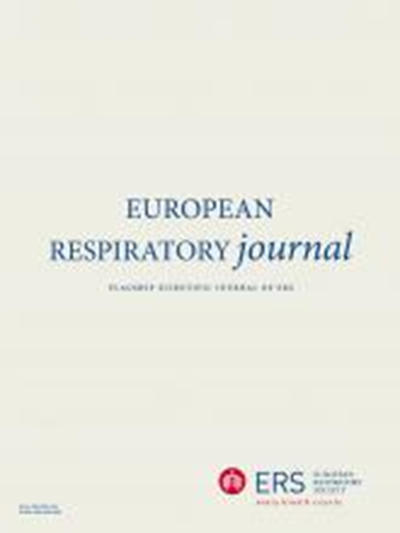囊性纤维化肺恶化的特征、治疗和肺功能结局:来自BEAT-CF队列的见解
IF 21
1区 医学
Q1 RESPIRATORY SYSTEM
引用次数: 0
摘要
肺恶化是囊性纤维化(pwCF)患者的重要临床负担。在调节治疗的背景下,是否应该改变病情恶化的管理尚不清楚。我们描述了需要静脉注射抗生素治疗(PERITs)的肺恶化的特征、治疗和肺功能结果,在一个快速扩大调节剂治疗的时代,当代澳大利亚pwCF队列。方法在2020年10月14日至2024年10月9日期间在11个澳大利亚专科中心接受治疗的spwcf患者进行前瞻性登记。系统地收集PERIT期间的肺活量测量数据和接受的治疗。结果共纳入982例pwCF患者,323例患者共记录593例PERITs。PERIT开始时的中位年龄为12岁(IQR:7-17), PERIT的平均基线ppFEV1为80% (sd:21%)。大约62% (n=366)的PERITs发生在接受调节剂治疗的患者中。静脉注射妥布霉素(63%)和哌拉西林-他唑巴坦(43%)是最常用的抗生素。在基线、第7天(n=296)或第60天(n=383)进行肺活量测定的参与者中,41% (n=120)和44% (n=169)在开始治疗后第7天和第60天分别低于基线;8%的患者在两个时间点的ppFEV1均低于基线水平10 ~ 10%。无论基线肺功能、铜绿假单胞菌定植或使用调节剂,恢复模式都是一致的。结论接受和未接受调节剂治疗的PERITs患者肺功能损害的模式和程度相似。这强调了继续需要证据来帮助临床医生平衡治疗负担和不可逆肺功能丧失的风险。本文章由计算机程序翻译,如有差异,请以英文原文为准。
Characteristics, treatment, and lung function outcomes of pulmonary exacerbations in cystic fibrosis: insights from the BEAT-CF cohort.
BACKGROUND
Pulmonary exacerbations pose a significant clinical burden on people with cystic fibrosis (pwCF). Whether management of exacerbations should change in the context of modulator therapy is unclear. We describe the characteristics, treatment and lung function outcomes of pulmonary exacerbations requiring intravenous antibiotic therapy (PERITs) in a contemporary Australian cohort of pwCF, in an era of rapidly broadening access to modulator therapy.
METHODS
PwCF receiving care at 11 Australian specialist centres were prospectively enrolled between 14 October 2020 and 9 October 2024. Spirometry data and treatments received during a PERIT were collected systematically.
RESULTS
A total of 982 pwCF were enrolled, with 593 PERITs recorded in 323 individuals. The median age at PERIT start was 12 years (IQR:7-17) and the mean baseline ppFEV1 across PERITs was 80% (sd:21%). Approximately 62% (n=366) of PERITs occurred in people receiving modulator therapy. Intravenous tobramycin (63%) and piperacillin-tazobactam (43%) were the most frequently used antibiotics. Among participants with spirometry at baseline and at Day7 (n=296) or Day60 (n=383), 41% (n=120) and 44% (n=169) were below their baseline at Day7 and Day60 after commencing treatment, respectively; 8% were >10% below their baseline ppFEV1 at both timepoints. Recovery patterns were consistent regardless of baseline lung function, Pseudomonas aeruginosa colonisation, or modulator use.
CONCLUSION
The pattern and magnitude of lung function impairment during PERITs is similar among those receiving and not receiving modulator therapy. This underscores the continued need for evidence to help clinicians balance treatment burden against the risk of irreversible loss of lung function.
求助全文
通过发布文献求助,成功后即可免费获取论文全文。
去求助
来源期刊

European Respiratory Journal
医学-呼吸系统
CiteScore
27.50
自引率
3.30%
发文量
345
审稿时长
2-4 weeks
期刊介绍:
The European Respiratory Journal (ERJ) is the flagship journal of the European Respiratory Society. It has a current impact factor of 24.9. The journal covers various aspects of adult and paediatric respiratory medicine, including cell biology, epidemiology, immunology, oncology, pathophysiology, imaging, occupational medicine, intensive care, sleep medicine, and thoracic surgery. In addition to original research material, the ERJ publishes editorial commentaries, reviews, short research letters, and correspondence to the editor. The articles are published continuously and collected into 12 monthly issues in two volumes per year.
 求助内容:
求助内容: 应助结果提醒方式:
应助结果提醒方式:


